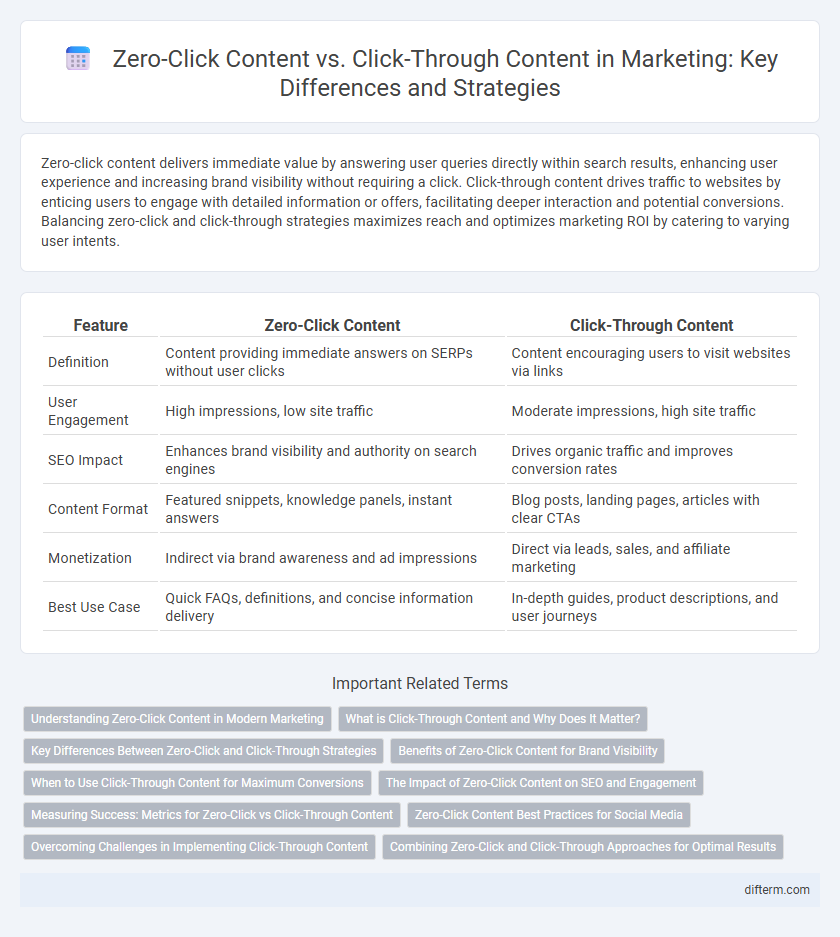Zero-click content delivers immediate value by answering user queries directly within search results, enhancing user experience and increasing brand visibility without requiring a click. Click-through content drives traffic to websites by enticing users to engage with detailed information or offers, facilitating deeper interaction and potential conversions. Balancing zero-click and click-through strategies maximizes reach and optimizes marketing ROI by catering to varying user intents.
Table of Comparison
| Feature | Zero-Click Content | Click-Through Content |
|---|---|---|
| Definition | Content providing immediate answers on SERPs without user clicks | Content encouraging users to visit websites via links |
| User Engagement | High impressions, low site traffic | Moderate impressions, high site traffic |
| SEO Impact | Enhances brand visibility and authority on search engines | Drives organic traffic and improves conversion rates |
| Content Format | Featured snippets, knowledge panels, instant answers | Blog posts, landing pages, articles with clear CTAs |
| Monetization | Indirect via brand awareness and ad impressions | Direct via leads, sales, and affiliate marketing |
| Best Use Case | Quick FAQs, definitions, and concise information delivery | In-depth guides, product descriptions, and user journeys |
Understanding Zero-Click Content in Modern Marketing
Zero-click content thrives on delivering immediate value through featured snippets, knowledge panels, and instant answers, reducing the need for users to click through to websites. This type of content enhances brand visibility on search engines like Google by capturing user attention directly on the results page, improving engagement metrics without traditional traffic. Marketers leverage zero-click strategies to optimize for voice search and mobile-first experiences, aligning with evolving consumer behaviors in modern digital landscapes.
What is Click-Through Content and Why Does It Matter?
Click-through content is designed to entice users to engage by clicking on links, driving traffic to websites or landing pages. Its effectiveness lies in increasing user interaction, improving conversion rates, and enhancing SEO rankings through higher click-through rates (CTR). Crafting compelling headlines and clear calls-to-action are essential strategies to maximize the impact of click-through content in marketing campaigns.
Key Differences Between Zero-Click and Click-Through Strategies
Zero-click content delivers answers directly on search engine results pages, emphasizing user convenience and faster information access, which reduces website traffic but enhances brand visibility. Click-through content aims to drive users to websites by enticing them with compelling headlines and meta descriptions, optimizing for engagement, conversions, and detailed content consumption. Key differences include user journey impact, SEO strategy focus, and performance metrics--zero-click prioritizes impressions and brand awareness, while click-through targets session duration and goal completions.
Benefits of Zero-Click Content for Brand Visibility
Zero-click content enhances brand visibility by delivering immediate answers directly in search engine results, reducing reliance on users clicking through to websites. This type of content increases exposure on high-traffic platforms like Google Featured Snippets and knowledge panels, positioning brands as authoritative sources. By capturing user attention instantly, zero-click content drives brand recognition and trust without the friction of additional clicks.
When to Use Click-Through Content for Maximum Conversions
Click-through content is most effective when the goal is to drive users from search engine results pages (SERPs) to your website, particularly for conversion-focused campaigns such as product launches, lead generation, or detailed service descriptions. This type of content encourages user engagement by providing clear calls-to-action (CTAs) and compelling reasons to visit your landing page for more information or to complete a purchase. Optimizing meta titles and descriptions with targeted keywords can increase click-through rates, maximizing conversion potential by attracting highly relevant traffic ready to take action.
The Impact of Zero-Click Content on SEO and Engagement
Zero-click content significantly affects SEO by providing instant answers that reduce user clicks but increase visibility in featured snippets and knowledge panels. This type of content enhances engagement through immediate value delivery, boosting brand authority and user satisfaction despite lower site traffic. Marketers must balance zero-click strategies with click-through content to maintain comprehensive audience interaction and optimize overall digital presence.
Measuring Success: Metrics for Zero-Click vs Click-Through Content
Measuring success for zero-click content involves tracking metrics such as impressions, engagement rates, and brand lift, which capture direct user interaction without site visits. Click-through content success is primarily gauged by click-through rates (CTR), conversion rates, and session duration, reflecting active user engagement and goal completions on the website. Comparing these metrics helps marketers optimize strategies by balancing brand awareness from zero-click content and actionable traffic from click-through content.
Zero-Click Content Best Practices for Social Media
Zero-click content on social media prioritizes delivering immediate value by providing answers or solutions directly within the post, enhancing user engagement without requiring a link click. Best practices include using concise headlines, clear visuals, and incorporating key information like FAQs, statistics, or tips that meet user intent instantly. Optimizing zero-click content boosts brand authority and retention while reducing bounce rates caused by unnecessary navigation.
Overcoming Challenges in Implementing Click-Through Content
Implementing click-through content faces challenges such as optimizing user engagement while balancing SEO goals with measurable traffic generation. Developing compelling, context-rich meta descriptions and integrating clear calls-to-action can increase click-through rates without sacrificing search visibility. Leveraging A/B testing and analytics tools helps marketers refine content strategies to overcome barriers to effective click-through content deployment.
Combining Zero-Click and Click-Through Approaches for Optimal Results
Combining zero-click content and click-through content strategies maximizes audience engagement by capturing both immediate information seekers and those interested in deeper exploration. Zero-click content, such as featured snippets and rich answers, enhances visibility on search engine results pages (SERPs) and drives brand authority without additional clicks. Integrating click-through content like blog posts, videos, and landing pages encourages further interaction, boosting conversion rates and customer retention through targeted messaging and comprehensive user experiences.
Zero-click content vs click-through content Infographic

 difterm.com
difterm.com